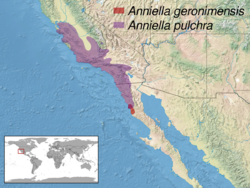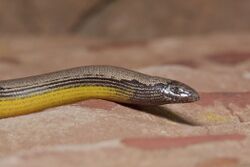Biology:Anniella pulchra
| California legless lizard | |
|---|---|

| |
| Scientific classification | |
| Domain: | Eukaryota |
| Kingdom: | Animalia |
| Phylum: | Chordata |
| Class: | Reptilia |
| Order: | Squamata |
| Family: | Anniellidae |
| Genus: | Anniella |
| Species: | A. pulchra
|
| Binomial name | |
| Anniella pulchra (Gray, 1852)
| |

| |
| Range of Anniella pulchra (sensu lato) in purple | |
Anniella pulchra, the California legless lizard, is a limbless, burrowing lizard often mistaken for a snake.
Description
These lizards are around 7 inches (18 cm) long from snout to vent (not including tail). They have small, smooth scales typically colored silvery above and yellow below, although black or dark brown forms exist in Monterey County, California[2] which were thought to be a separate subspecies at one point.[3]
Taxonomy
There were formerly two subspecies of California legless lizard recognized based on individual color morphs: the silvery legless lizard, A. p. pulchra, and the black legless lizard, A. p. nigra. However, contemporary taxonomy considers them simply a melanistic morph.[4] More recently (in 2013), A. pulchra has been split up into five different species: A. pulchra (with a narrower definition), A. alexanderae, A. campi, A. grinnelli, and A. stebbinsi.[5][6]
Distribution and habitat
They live in loose, sandy soils or leaf litter, typically in sand dunes along the coast. They are found from Contra Costa County in northern California, all the way south to Baja California, although occurrences are often scattered. They require moisture to aid in shedding their skin. Without it, their vision and feeding can be affected, potentially starving the animal.[7]
Diet
Their diet consists of mainly beetles, larval insects, termites, ants, and spiders.
Reproduction
Males are slightly smaller than females[citation needed], otherwise there is no discernible difference between the two sexes. Females are ovoviviparous and probably breed between early spring and July, with 1 to 4 young born September–November. Young lizards resemble their parents except look like smaller versions of them.
References
- ↑ Hollingsworth, B.; Hammerson, G.A. (2007). "Anniella pulchra". IUCN Red List of Threatened Species 2007: e.T62227A12582107. doi:10.2305/IUCN.UK.2007.RLTS.T62227A12582107.en. https://www.iucnredlist.org/species/62227/12582107.
- ↑ Kuhnz, Linda A.; Burton, Robert K.; Slattery, Peter N.; Oakden, James M. (2005-01-01). "Microhabitats and Population Densities of California Legless Lizards, with Comments on Effectiveness of Various Techniques for Estimating Numbers of Fossorial Reptiles". Journal of Herpetology 39 (3): 395–402. doi:10.1670/126-04a.1.
- ↑ CaliforniaHerps.com on Anniella pulchra
- ↑ CaliforniaHerps.com on the former A. p. nigra "subspecies"
- ↑ Papenfuss, Theodore J.; Parham, James F. (2013). "Four New Species of California Legless Lizards (Anniella)". Breviora 536: 1–17. doi:10.3099/MCZ10.1.
- ↑ Anniella in the Reptile Database
- ↑ Animal Diversity Web: Anniella pulchra
Wikidata ☰ Q2661640 entry



